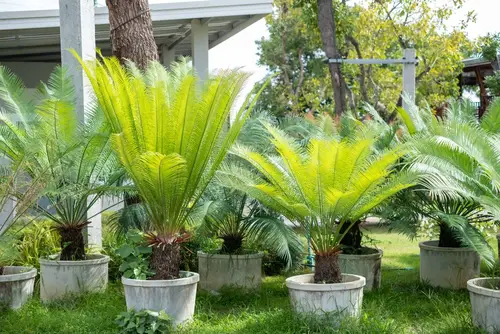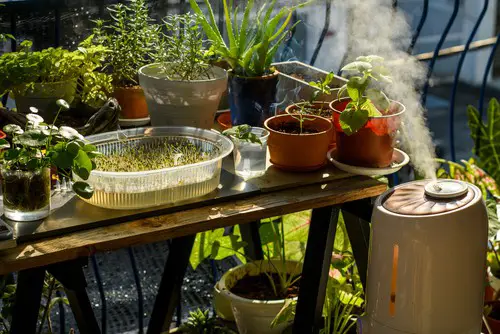Indoor palm trees are a popular choice for homeowners who want to add a touch of tropical greenery to their indoor space. However, it can be frustrating when the leaves of their indoor palm tree start to turn yellow.
Yellowing leaves can be a sign of a problem with the tree’s health, and it is important to identify the cause of the problem in order to fix it.
Understanding palm trees is an important first step in figuring out why your indoor palm tree is turning yellow. Palm trees require specific conditions to thrive, including the right amount of sunlight, water, and nutrients.
When these conditions are not met, the tree can become stressed and its leaves can start to turn yellow. There are several common reasons why indoor palm trees may start to turn yellow, including nutrient deficiencies, soil and drainage conditions, pest infestations, and disease.
Identifying the cause of indoor palm tree turning yellow is the key to finding a solution. Depending on the cause, there are several preventive measures and solutions that homeowners can take to help their indoor palm tree recover.
By taking the right steps, it is possible to restore the tree’s health and keep it looking lush and green for years to come.
Key Takeaways
- Indoor palm trees require specific conditions to thrive, and yellowing leaves can be a sign of a problem with the tree’s health.
- Common reasons for indoor palm trees turning yellow include nutrient deficiencies, soil and drainage conditions, pest infestations, and disease.
- Identifying the cause of yellowing leaves is the key to finding a solution, and there are several preventive measures and solutions that homeowners can take to help their indoor palm tree recover.
Check out these other top posts:
- Why Is My Horsetail Plant Turning Yellow?
- Pilea Plant Turning Yellow
- Why Is My Ginger Plant Turning Yellow?
Understanding Palm Trees

Palm trees are a popular choice for indoor plants due to their exotic appearance and low maintenance requirements. They are evergreen plants that belong to the Arecaceae family and come in different species, each with its unique characteristics.
Indoor palm trees are known for their ability to purify the air by removing toxins and producing oxygen. They are also good at regulating humidity levels and can add a tropical touch to any room.
However, indoor palm trees can sometimes turn yellow, which can be concerning for plant owners. Understanding the reasons behind this can help prevent and treat the issue.
Yellowing leaves in indoor palm trees can be caused by a variety of factors, including nutrient deficiency, overwatering, underwatering, pests, diseases, and environmental stressors. Different palm species have different requirements, so it’s important to understand the specific needs of your plant.
Some popular indoor palm species include Areca palm, Kentia palm, and Parlor palm. Areca palms are known for their feathery fronds and can grow up to 6-7 feet tall. Kentia palms have long, slender trunks and can grow up to 10-12 feet tall. Parlor palms are smaller and more compact, making them ideal for smaller spaces.
Why Is My Indoor Palm Tree Turning Yellow – 6 Common Problems
Indoor palm trees are a popular choice for adding a touch of greenery to any home or office. However, it can be concerning when the leaves start to turn yellow. Here are some common reasons why indoor palm trees may experience yellowing:
1. Light Conditions
Palm trees require bright, indirect light to thrive. If the tree is not receiving enough light, the leaves may start to yellow. Conversely, too much direct sunlight can also cause yellowing. It is important to find a balance and adjust the location of the plant accordingly.
2. Watering Issues
Overwatering or underwatering can both cause yellowing leaves. Overwatering can lead to root rot, which can prevent the plant from absorbing necessary nutrients.
Underwatering can cause the leaves to dry out and turn yellow. It is important to find a watering schedule that works for the specific type of palm tree and the environment it is in.
3. Humidity Factors

Palm trees prefer a humid environment. If the air is too dry, the leaves may start to yellow. Using a humidifier or placing a tray of water near the plant can help increase the humidity levels.
4. Temperature Effects
Palm trees prefer warm temperatures and can be sensitive to cold drafts. If the plant is exposed to temperatures below 50°F (10°C), the leaves may start to yellow. It is important to keep the plant away from drafty windows or doors.
5. Pest Infestation
Pests such as spider mites and aphids can cause yellowing leaves. It is important to inspect the plant regularly and treat any infestations promptly.
6. Disease Problems
Certain diseases such as Ganoderma butt rot, Fusarium wilt, and Phytophthora root rot can cause yellowing fronds. It is important to identify any signs of disease early and take appropriate action.
Nutrient Deficiencies
Indoor palm trees require a balanced supply of essential nutrients to stay healthy and green. A nutrient deficiency can cause yellowing of the leaves, stunted growth, and even death. Here are some of the most common nutrient deficiencies that can cause yellowing of palm tree leaves.
1. Nitrogen Deficiency
Nitrogen is a vital nutrient that helps plants build proteins and chlorophyll. A lack of nitrogen can cause the leaves to turn yellow or pale green. In severe cases, the leaves may even fall off.
To fix this deficiency, apply a slow-release fertilizer that contains nitrogen. It is recommended to fertilize indoor palm trees every 2-3 months during the growing season.
2. Manganese Deficiency

Manganese is an essential nutrient that helps plants produce chlorophyll and aids in the photosynthesis process. A lack of manganese can cause yellowing of the leaves, especially in the areas between the veins.
In severe cases, the leaves may become distorted and have brown spots. To fix this deficiency, apply a fertilizer that contains manganese.
3. Magnesium Deficiency
Magnesium is a crucial nutrient for plant growth and plays a vital role in the production of chlorophyll. A lack of magnesium can cause yellowing of the leaves, starting from the tips and spreading towards the base.
In severe cases, the leaves may even curl or become brittle. To fix this deficiency, apply a slow-release fertilizer that contains magnesium.
4. Potassium Deficiency
Potassium is an essential nutrient that helps plants regulate water balance and aids in the production of sugars and starches. A lack of potassium can cause yellowing of the leaves, starting from the tips and edges. In severe cases, the leaves may have brown spots or edges. To fix this deficiency, apply a fertilizer that contains potassium.
5. Iron Deficiency
Iron is an essential nutrient that helps plants produce chlorophyll and aids in the photosynthesis process. A lack of iron can cause yellowing of the leaves, starting from the base and spreading towards the tips.
In severe cases, the leaves may become pale and almost white. To fix this deficiency, apply a slow-release fertilizer that contains iron.
Soil and Drainage Conditions
One of the most common reasons for yellowing leaves in indoor palm trees is poor soil and drainage conditions. Overwatering and poor drainage can cause root rot, which can lead to yellowing and drooping leaves. On the other hand, dry soil around the root ball can cause the palm tree’s leaf tips to turn brown and droop.
To ensure that the soil and drainage conditions are optimal for the indoor palm tree, it is important to use a well-draining soil mixture. A good potting mix for indoor palm trees should contain perlite, which helps with drainage and aeration. It is also important to ensure that the pot has drainage holes to allow excess water to escape.
The pH level of the soil can also affect the health of the indoor palm tree. A soil test can help determine the pH level and the nutrient content of the soil.
The optimal pH level for indoor palm trees is between 6.0 and 7.0, which is slightly acidic to neutral. If the pH level is too high or too low, it can affect the absorption of nutrients by the roots.
Poor drainage can also be caused by the type of potting mix used. If the potting mix is too dense, it can retain water and prevent proper drainage. Adding perlite to the potting mix can help improve drainage and prevent root rot.
Preventive Measures and Solutions

To prevent indoor palm trees from turning yellow, it is important to take proper care of the plant. Here are some preventive measures and solutions that can help keep your palm tree healthy and vibrant:
1. Light
Indoor palm trees require bright, indirect light to thrive. Placing the plant in a location that receives insufficient light can cause yellowing of the leaves. On the other hand, too much direct sunlight can also damage the plant. It is recommended to place the plant near a window that receives bright, indirect light.
2. Humidity
Indoor palm trees thrive in humid environments. Low humidity levels can cause the leaves to turn yellow and brown. To increase humidity levels, consider using a humidifier or placing a tray of water near the plant.
3. Moisture
Overwatering or underwatering indoor palm trees can cause yellowing of the leaves. It is important to maintain the proper moisture level in the soil. The soil should be moist but not waterlogged. To test the moisture level, stick your finger into the soil about an inch deep. If the soil feels dry, it is time to water the plant.
4. Winter Care
During the winter months, indoor palm trees may require less water and fertilizer. It is important to adjust the watering schedule and reduce the amount of fertilizer to prevent yellowing of the leaves.
5. Stress
Stress can also cause indoor palm trees to turn yellow. Stress can be caused by changes in the environment, such as extreme temperatures or a sudden change in the watering schedule. To reduce stress, it is important to maintain a consistent watering schedule and keep the plant in a stable environment.
6. Containers
Indoor palm trees should be planted in containers that allow for proper drainage. Improper drainage can cause the soil to become waterlogged and lead to yellowing of the leaves.
By following these preventive measures and solutions, indoor palm trees can remain healthy and vibrant.
Pest Control

If yellowing leaves are accompanied by tiny webs or black spots, it could be a sign of spider mites or scale insects infestation. These pests are common in indoor palm trees and can be difficult to control. It is important to identify the pest infesting the palm tree to determine the appropriate treatment.
One effective way to control spider mites and scale insects is through the use of insecticidal soap. This product is safe for indoor plants and can be applied directly to the leaves and stems of the palm tree. It works by suffocating the pests and disrupting their life cycle.
Another option is to use horticultural oil, which can also be applied directly to the leaves and stems of the palm tree. This product works by smothering the pests and preventing them from breathing.
If the infestation is severe, it may be necessary to treat the palm tree with a systemic insecticide. This type of product is absorbed by the plant and can provide long-lasting control of pests.
Regular monitoring of the palm tree is important to catch any pest infestations early. This can be done by inspecting the leaves and stems for signs of pests or damage. Keeping the palm tree healthy and well-watered can also help prevent pest infestations.
Disease Management
When it comes to managing diseases that cause yellowing of indoor palm trees, early detection is key. Some of the common fungal diseases that affect indoor palm trees include Fusarium wilt and leaf spot. These diseases are caused by fungi that thrive in warm and humid conditions.
If the palm tree is affected by a fungal infection, it is important to remove the infected leaves as soon as possible. This will help prevent the spread of the infection to other parts of the tree. Additionally, it is recommended to reduce the humidity levels in the room and ensure that the palm tree is not overwatered.
Fungicides can also be used to treat fungal infections. However, it is important to use the appropriate fungicide for the specific fungal infection affecting the palm tree. It is recommended to consult with a professional before applying any fungicide to ensure that it is safe and effective.
Preventing fungal infections is also crucial in managing diseases that cause yellowing of indoor palm trees. This can be achieved by maintaining good hygiene practices, such as regularly cleaning the leaves and ensuring that the soil is well-draining.
In some cases, if the palm tree is affected by a severe fungal infection, it may be necessary to remove the entire tree to prevent the spread of the infection to other plants in the vicinity. However, this should only be done as a last resort.
Frequently Asked Questions

What causes yellow leaves on indoor palm trees?
Yellowing leaves on indoor palm trees can be caused by various factors, including natural aging, pest infestations, nutrient deficiencies, and environmental stressors such as excessive heat or cold.
Identifying the root cause of yellowing is crucial because it can indicate what needs to be done to save the palm plant from further damage or death.
How can I prevent my indoor palm tree from turning yellow?
To prevent indoor palm trees from turning yellow, it is important to provide them with proper care and maintenance. This includes regular watering, fertilization, and pruning.
It is also important to ensure that the palm tree is placed in an area with adequate sunlight and temperature control.
What are some common reasons for indoor palm trees to turn yellow?
Some common reasons for indoor palm trees to turn yellow include over or under watering, nutrient deficiencies, pests, diseases, and environmental stressors such as excessive heat or cold.
It is important to identify the cause of yellowing leaves to take the appropriate action to save the plant.
Can yellow leaves on an indoor palm tree be saved?
In some cases, yellow leaves on an indoor palm tree can be saved by identifying the cause of yellowing and taking appropriate action. This may include adjusting watering and fertilization schedules, treating pests or diseases, or moving the plant to a more suitable environment.
What is the best way to care for indoor palm trees to avoid yellowing?
The best way to care for indoor palm trees to avoid yellowing is to provide them with proper care and maintenance. This includes regular watering, fertilization, pruning, and ensuring they are placed in an area with adequate sunlight and temperature control.
It is also important to monitor the plant for signs of pests or diseases and take appropriate action if necessary.
When should I be concerned about yellowing leaves on my indoor palm tree?
If yellowing leaves on an indoor palm tree persist despite proper care and maintenance, it may be a sign of a more serious issue such as a pest infestation or disease.
It is important to identify the cause of yellowing leaves and take appropriate action to save the plant. If unsure, it is best to consult a professional for advice.

Hey, I’m Lisa and I’ve been an avid gardener for over 30 years. I love writing, talking and living in the garden! Feel free to connect with me on my socials below


